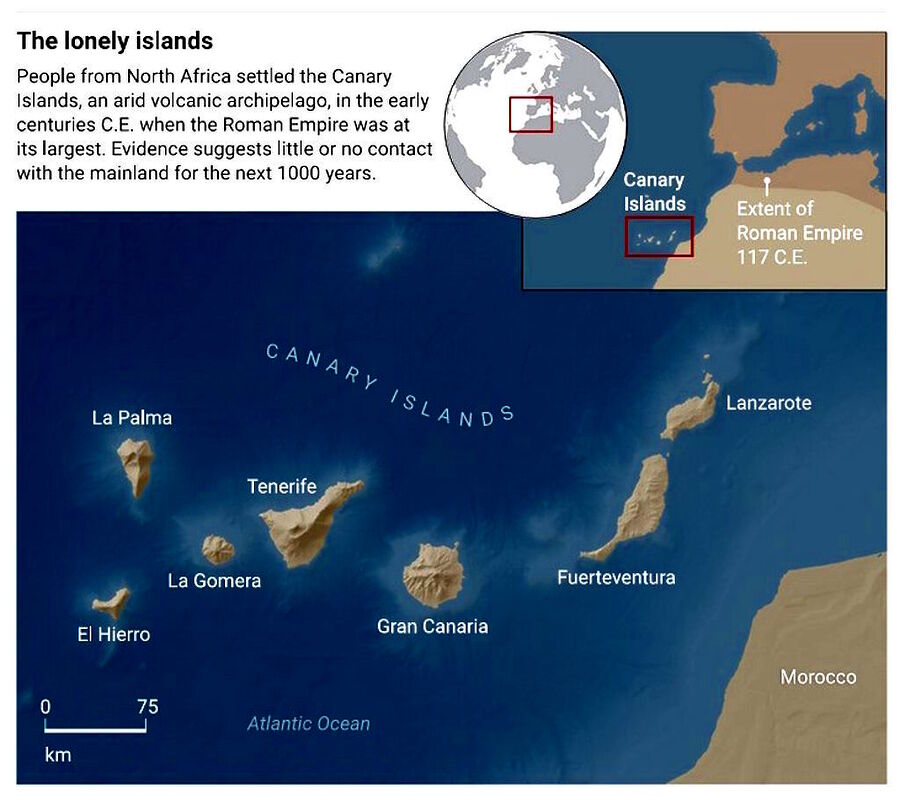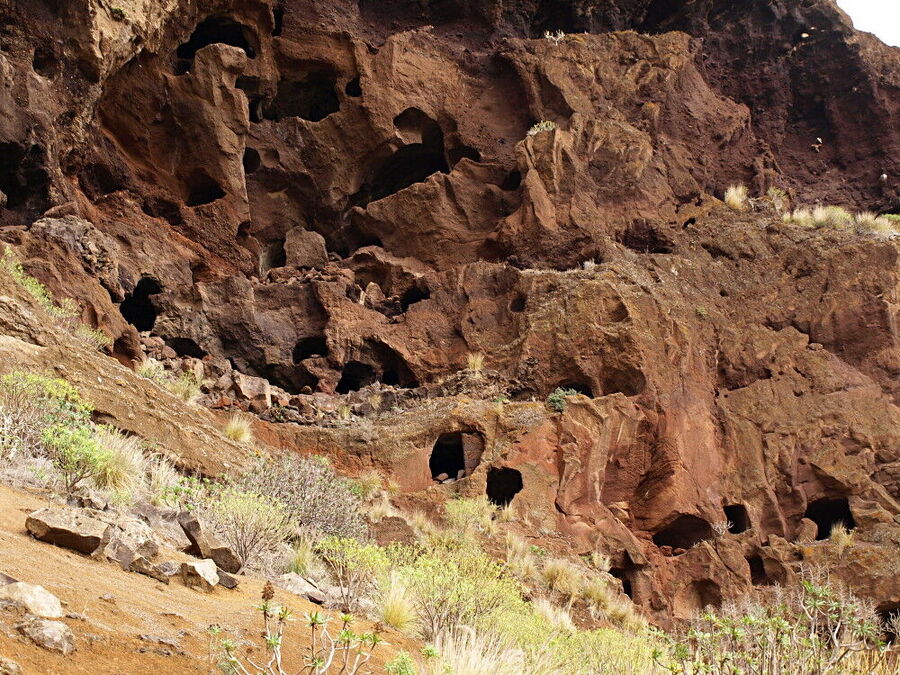The Canary Islands — More than 1000 years ago, a young man stood on the northern shore of the island now known as El Hierro. Across the wave-swept Atlantic Ocean, he could see the silhouettes of other islands, a volcanic peak on one soaring toward the clouds only 90 kilometers away. Yet, for him, those islands were as unreachable as the Moon.
His body betrayed the rigors of life on his arid volcanic outcrop. His molars were worn almost to the gums from grinding fibrous wild fern roots. His ancestors here had farmed wheat, but he and his contemporaries grew only barley and raised livestock such as goats. His genes held evidence that his parents were closely related, like many of the roughly 1000 people on the island, who had not mingled with outsiders for centuries. Also like many of his fellow islanders, he bore signs of an old head injury, likely sustained in a fight.
"This population faced a lot of challenges," says archaeologist Jonathan Santana of the University of Las Palmas de Gran Canaria (ULPGC). "Survival on this island was a challenge every day."

By applying the latest archaeological tools to this trove of material, Santana and other home-grown archaeologists are unearthing their stories, shedding light on puzzles that have mystified archaeologists since the 19th century. For instance, how did people with no apparent seafaring skills reach and survive on the archipelago? Why did their crops and cultures differ from island to island despite their common origin? The answers offer insights into how human societies cope with — and respond to — challenging environments, says Scott Fitzpatrick, a University of Oregon archaeologist who studies island cultures. "The Canaries have been sort of an enigma."
The Canary archipelago sits like a small curving tilde 100 kilometers off the North African coast (see map, below). Its major islands range in size from El Hierro, the smallest at 269 square kilometers, to Tenerife, more than seven times larger, roughly the size of Maui. The islands' volcanoes, some of which are still active, reach up to 3718 meters. Vegetation ranges from parched cacti to shrubland with wild olives and juniper. On a few islands, evergreen forests of pine and laurel thrive on moisture brought by northeasterly trade winds.

European archaeologists were fascinated with the early Canarians. The French thought the first settlers were Cro-Magnon, like prehistoric people in France; German archaeologists thought they must have been Aryan; the Spanish thought they were Stone Age relatives of the same North Africans who settled the Iberian Peninsula. More recently, archaeologists from the Canaries themselves have begun to lead investigations. They have tapped into evidence including ancient bones, the genes of living people, and 1000-year-old grains of barley.
By analyzing ancient DNA from radiocarbon-dated bones, archaeologists in the past 15 to 20 years have found that the first islanders had the strongest genetic ties to the Amazigh cultures of northwestern Africa, also known as Berbers. Rock inscriptions on the islands also echo Amazigh alphabets. Two thousand years ago, North Africa was home to a variety of Amazigh societies, from pastoral herders in rural tribes to kingdoms with large urban centers heavily influenced by Roman culture.
In the latest genetic study, published in Nature Communications in 2023, a team led by geneticist Rosa Fregel of the University of La Laguna sequenced the whole genomes of 49 ancient individuals spanning all major islands and dated from about 300 to 1500 C.E. Her team found that distinct genetic groups, each tied to Amazigh populations, had settled the western and eastern clusters of islands.
People from North Africa settled the Canary Islands, an arid volcanic archipelago, in the early centuries C.E. when the Roman Empire was at its largest. Evidence suggests little or no contact with the mainland for the next 1000 years.
But DNA doesn't answer how the first settlers crossed the watery gulf from the mainland. Peter Mitchell, an archaeologist at the University of Oxford, dismisses speculation that they were deported to the islands by Romans expanding into Africa in the first century C.E. Archaeological and written evidence shows the Romans knew of the islands and briefly operated a dye factory on a tiny outcrop there, extracting a prized purple hue from a marine snail. But Mitchell says the Romans had no practice of wholesale deportations of communities, usually opting to kill or enslave troublesome groups.
Instead, Mitchell suggests the Amazigh settlers took to the sea to escape conflicts sparked by a drying climate or the Roman expansion. Some islands might have seemed like an oasis compared with the desert from which those settlers came. "People might think going over the Atlantic to get here, 'This is quite worth it. We've never seen so many trees,'" Mitchell says.
Santana hypothesizes that people's seafaring skills declined over time because they had little incentive to traverse the ocean for trade. The islands' volcanic rock contains no valuable metal ore, and the dry ground yielded little food to spare. "It wasn't worth it," Santana says.
A dark cave entrance beckons from the middle of a 140-meter-tall cliff flanking a narrow valley on Gran Canaria. Jacob Morales, an archaeobotanist at ULPGC, crouches at the end of a ledge, the wind whipping his face. Below him lies a landscape of stunted shrubs, dry grasses, and precipitous, rocky ridges that Spanish philosopher and poet Miguel de Unamuno once described as "una tempestad petrificada" (a petrified storm). A 2-meter gap of blank sheer rock separates Morales from the cavern.
Morales doesn't plan to cross that blank wall today. But in 2011, he choked back his fear of heights and made his way up to the cave with the aid of ropes set by a rock climber. Researchers at the local archaeological museum wondered why he bothered, he recalls. Other archaeologists had entered the cave as early as the 1980s and toted away the obvious artifacts — bits of basketry and pottery. But Morales was hunting smaller quarry. Sifting through piles of sediment, he picked out tiny fragments of seeds representing a rich variety of foods: barley, durum wheat, lentils, fava beans, and figs. Radiocarbon dating revealed the seeds were as much as 1000 years old; all predated the arrival of Europeans. "It's amazing preservation," he says.

The granaries and their variety of foods also suggest that Gran Canaria, where central highlands capture up to 1 meter a year of rainfall compared with 10 to 20 centimeters elsewhere, was one of the most productive islands in the archipelago. Even today, the mesa topping the cliff above the granary "is the best place for cultivating barley in this area," Morales says.
The barley grown there today traces its lineage back to the ancient granaries. Morales and Swedish researchers analyzed DNA in barley seeds found in dwellings and granaries from three islands dating between 1000 and 600 years ago. Each island had a different strain descended from a single shared variety, which itself separated from African barley about 2000 years ago, according to genetic estimates. All the strains were genetically distinct from today's European and North African barley. The team also analyzed other crops; seed by seed, they pieced together evidence that a similar "packet" of domesticated African crops arrived with the first settlers of each island.

The genetic differentiation in barley is mirrored in the archipelago's people, painting a picture of profound separation from both other islands and the mainland. For example, the genetic split between people colonizing the western and eastern islands persisted even in remains dated to hundreds of years after the islands were settled. "If migration were something that was super common between islands, we shouldn't see two clusters [persist]," Fregel says.
Still, some archaeologists do see signs of new arrivals, at least on Gran Canaria, in changes in how the dead were treated. The first burials, around 300 C.E., were interred communally in caves, says Verónica Alberto-Barroso, an archaeologist at ULPGC. Around 600 C.E., some people began interring bodies in individual open-air tombs of piled rocks, a trend that lasted about 500 years. Then around 1200 C.E., stone-lined pits and graves grew popular. Alberto-Barroso and her colleagues also note simultaneous shifts in where people lived on the island, and the kinds of homes and ceramics they made. They conclude new North African groups with new cultural practices might have arrived during these periods.
But the changes could simply mark cultural evolution, Santana notes. Other islands don't show such cultural shifts and some display even stronger signals of genetic isolation. Fregel found that in ancient human remains from four islands — Fuerteventura, Lanzarote, La Gomera, and El Hierro — the chromosomes inherited from each parent were closely related, a sign of a small, inbred population. At least one individual on each island had chromosomes more similar than if their parents had been first cousins.
On El Hierro, Fregel analyzed shared genetic variants in four individuals who died between the 13th and 15th centuries. None of these people were directly related, but the similarities in their DNA suggested a recent common ancestor — a sign of a population bottleneck. The population apparently crashed around the ninth century, well after the islands were settled. "It was super drastic," Fregel says.
The apparent ninth century crisis coincides with the onset of warmer than average global temperatures, in a time known as the Medieval Warm Period. Fregel wonders whether the warmth might have brought climate change and famine. But ancient DNA from 34 people on more populous Tenerife and Gran Canaria shows no signs of a population collapse.
"To me that's the most interesting thing," Fregel says. "We imagined that all the islands would be the same. We are realizing that each island had a different scenario."
The people of all the islands do exhibit some similar signs of hardship. In Santana's basement lab on Gran Canaria, the skull of the unnamed young man from El Hierro rests on a table in a plastic tray alongside nine others. Many skulls bear small dents, some the size of nickels, others of silver dollars — the marks of blows. "The rate of interpersonal violence is very, very high," Santana says.
On Gran Canaria, Alberto-Barroso and colleagues reported in 2018 that 27% of 347 adult skulls collected from burial caves show signs of trauma, usually long before the person died. Roughly one-third of male skulls were damaged, and nearly 20% of the female skulls. Most of the injuries were from something like a club or stone on the left side of the front of the skull, consistent with face-to-face fighting. The injury rate is far higher than in other ancient burial sites, including ones in the Iberian Peninsula, New Guinea, and the Solomon Islands, the researchers reported.
Other islands are even more extreme, according to unpublished research by Hemmamuthé Goudiaby, an archaeologist at Archaïos, an archaeological company. For instance, of 82 skulls from El Hierro, 50% of male skulls and 28% of female skulls show signs of trauma. "These populations that seem to have a higher incidence of interpersonal violence are also the ones that live on islands with less available resources," Goudiaby notes.
He and Santana suggest ritualized violence — orchestrated fights or duels — might have served as a way to address conflicts in communities where food was in short supply and there were few options to move away.

He stresses that early Canarian societies showed remarkable adaptability. The first settlers almost certainly came from places with metallurgy, yet, faced with a world without metal ore, they reinvented tools of stone, wood, and bone. And they enjoyed culturally rich lives, as shown by intricately woven tapestries, clay figurines, stone etchings, and — on the wall of at least one Gran Canaria cave — elaborate geometric paintings that may represent a calendar system.
Then, the Europeans arrived. The violence of traditional Canarian life pales in comparison. The first known contact happened in the early 1300s, when Italian navigator Lancelotto Malocello settled on the island now known as Lanzarote. In 1402, soldiers of Spain's Castilian monarchy landed on Lanzarote in force, beginning a century of conquest that ended in 1496 with Spanish victory over Indigenous warriors on Tenerife. The Indigenous people were killed, enslaved, forcibly assimilated, or deported, save a scattered few. On Gran Canaria, an Indigenous population estimated at between 10,000 and 60,000 was slashed to as few as 2000.
The genocide was almost complete. No Indigenous Canarian community survives today. Only scraps of language, such as names for places, foods, or famous leaders, remain. And yet, traces of the early settlers live on. "We were told all of the Indigenous people disappeared," Santana says. "It's not true. We know that because of the DNA results."
In a string of papers beginning in the early 2000s, Fregel and colleagues found that, on average, between 15% and 20% of current islanders' DNA comes from Indigenous sources. Local newspapers trumpeted the findings with pride, as they did the discovery by Morales and colleagues that today's Canarian barley is genetically similar to the ancient island variety.

"Your genome is telling you a story about your ancestors. But your identity is defined by your experience, your family, your friends," says Fregel, who was born and raised on Tenerife. When she tested her DNA, it was about 20% Indigenous. "I wouldn't feel any less Canarian if my DNA was from a whole other region."
Still, her findings and those from Santana and Morales have bolstered a modern-day Canarian identity that emerged as the country moved beyond the nationalist conformity enforced under Spanish dictator Francisco Franco, who died in 1975. A year later, when Morales was born, his uncle paid his mother the equivalent of 60 euros to give Morales a middle name evoking an ancient Canarian leader: Bentejui.
Morales says his work can help "build memory, and thus identity, for the people who had very little historical documentation." In one example, Canarian chefs and beermakers have reached out to the scientists about using barley with DNA traced to the ancient Canarian stock. "So much knowledge was really lost when the Spanish conquered the islands," says Jenny Hagenblad, a plant evolution geneticist at Linköping University who works with Morales. "It's pretty cool that we can break through this loss of information and we can, in a sense, eat the same things. It is a very living link to the past."






Remnants of a major society all over these islands, not even mentioned.
When you say Atlantis, everyone shuts down discussion, but right where Plato saiid it was, outside the gates of Hercules ie Gibraltar, and here we have a volcanic chain.
Also, no mention of the haplogroups here, that match ancient Iberian haplogroups, circa 3500 bc, the megalithic sea faring culture with common ogham type script and seafaring expertise.
Also, no mention of Phoenician seafarers finding these islands as well, circa 250 bc .The buildings the Native Canarians Lived in resemble ancient dwellings in Iberia, as well as in the Chacapoya area of the Amazon.These in turn are similar to ancient Crannogs in Ireland.
If Thor Heyerdahl could travel across an ocean in a reed boat to prove diffusion, certainly these islanders could have built reed boats as well, similar to the boats made in Lake Titicaca, 12000 feet above sea level. The article starts with molars worn from bashing reeds, maybe not for food but for sewing reed boats together.
Articles like this smack of DEI mentality, your dna does not make your being is so ridiculous a perspective, especially a Norse/Scandinavian scientist saying that about Canary Island people.
Blaming the Spaniards for conquering these islands is like blaming a river for people drowning, because they cannot swim!
And the Spaniards did not teach these Canarians to smash each other’s heads in, that’s survival of the fittest, but the Karen’s would have us save all kinds of culdesac human varieties, like Kurt Vonnegut’s Tralfamadorians in Slaughter house five, keeping humans in bubble planets for amusement. At least the Tralfamadorians admit it.
We are slowly seeing the costs of allowing all sorts of people to reproduce at will, with society bearing the brunt now of mentally ill transgender people, less that .5 % of our population, coercing the failed feminist careerists , covered in cat hair ,wishing they had children now nto look after them in the onset of old age, and these cat lady Karen’s speak madness to power by supporting the trans movement, that the Sackler family Purdue Pharma , responsible for the Oxycotin addiction, and who produce the trans hormone meds( yes, same effin family ) and when the Karen’s mentality is questioned, they lash out at anything the nuclear family still holds dear.
The middle aged White Karen’s will ruin everything white Christian Families, Clans Civilizations and societies have built in the last 4500 years, the Muslims are right to have their women at home raising their next generation, that is a sustainable culture. What more noble role in humankind is there, but motherhood!!! The essence of being.
we throw it away at our own peril.
terrible dei article, expect better on here.